MUSEUM EYE: ‘National Treasures—a people’s archive’
Published in Issue 4 (July/August 2018), Reviews, Volume 26NMI Country Life, Turlough Park, Castlebar, Co. Mayo
www.museum.ie, www.nationaltreasures.ie
By Tony Canavan
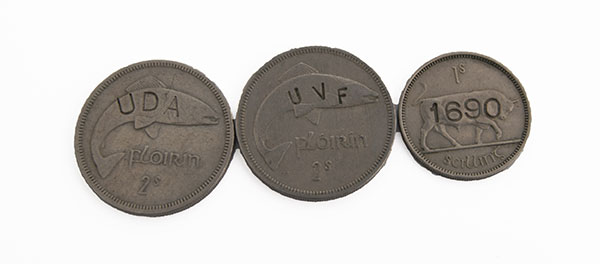
Above: ‘Southern coins that were stamped with loyalist emblems and sent back into circulation in the Republic. Acquired by my father.’ Submitted by Phillippe O’Sullivan.
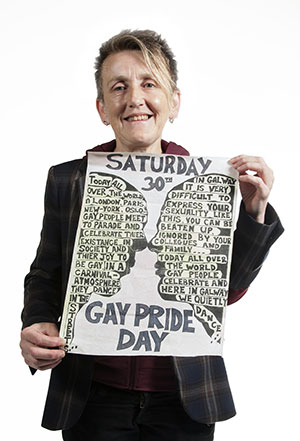
Above: First Galway LGBT Pride poster. ‘I helped to found the Gay/Lesbian hotline in Galway. My friend Jane Talbot designed the poster on a Thursday and we had the Pride Parade on Saturday 30th.’ Submitted by Nuala Ward.
I have to admit that I was expecting a lot from this exhibition. It is based on four RTÉ programmes from the four provinces in which thousands of ordinary people brought their ‘treasures’ along for consideration. The resulting exhibition in the National Museum’s Country Life wing has been widely advertised. Given all that, I expected a full-scale exhibition packed with hundreds of objects that could rightly be called treasures. Instead, the Museum has staged a temporary
exhibition (running until 31 August) of only 72 artefacts.
Things begin well, with large banners and a video from the TV show running on a loop, but I was surprised to discover that the exhibition itself consisted of only eight display cabinets and some free-standing items in the entrance hall to the galleries building. The fact that the TV among these display cabinets was not working is perhaps indicative of the approach taken to ‘National Treasures’.
I went from case to case expecting to find something outstanding, something with the ‘wow’ factor to justify the hype, but I was disappointed. If one delves into each object, there is something interesting about each, but there is not much of the kind of thing that any museum does not already possess and not much that most of us don’t have in our own homes. In our house, for example, we have a plastic bullet, a papal blessing for a 1950s marriage, a photograph of Irish soldiers on field exercises during the Emergency, a souvenir of JFK’s visit, and so on.
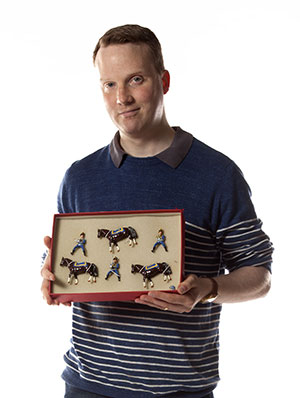
Above: ‘Britain’s lead models of the Blue Hussars presidential escort—one of the few model sets that Britain’s made of Irish military units post-independence.’ Submitted by Fergal Browne.
This is not to say that there was nothing worth seeing. Things like the ‘Free State corset’, the Belfast Celtic jersey, the Blue Hussars model and so on are all interesting and do tell us something about the history of modern Ireland. It was worthwhile, too, to see so much social history reflected in objects like posters (e.g. Gay Pride and Save Wood Quay), a 1920s flapper dress, Waterford glass and a 1950s Sunbeam swimsuit. And what made them all the more interesting were the stories behind them.
Rarely in a museum do we get the back story to an object—not just who donated it but also its significance to the donor. This is the real strength of ‘National Treasures’ and its strongest recommendation. People tell their own stories and these objects come to life—for example, Frank Smith’s story of the 1918 Voting Registration Slip, the first time women could vote, or Mary Moriarty talking about her father the tinsmith and the tin lantern on display.
The project proclaims that ‘National Treasures’ is a ‘crowd-sourced tapestry of our shared history, culture and heritage’, and this is true to an extent. Most of the objects on display represent the ‘ordinary’ lives of ‘ordinary’ people, but they also reveal the stories of ordinary people caught up in big historical events, and many of the items on display relate to the struggle for independence, the First World War and the
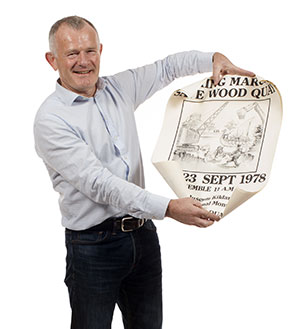
Above: Wood Quay protest poster. Submitted by Kevin Ecock.
Northern Troubles, for example, as well as developments of major social significance in education, sport, entertainment and gender rights. All this is quite a breadth for a relatively small exhibition.
Perhaps it is wrong to judge ‘National Treasures’ by ‘normal’ standards. It is the TV programmes and the video running in the exhibition that make it unusual and even worthwhile. The term ‘living history’ is often bandied about but in this case it is true. Almost every item in the exhibition has a link to people living today or their parents or grandparents. I have to admit that I spent more time watching the video than viewing the objects. The stories people told were interesting, and seeing the object in someone’s hand somehow makes it more significant than seeing it in a display cabinet.
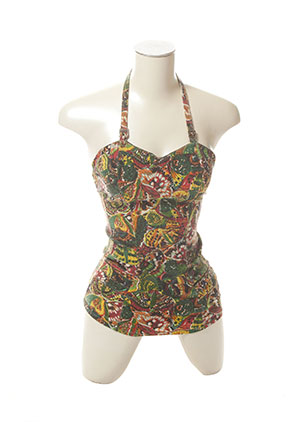
Above: Sunbeam swimsuit. ‘It’s probably from the late ’50s, early ’60s. It was made by Sunbeam, a factory on the northside of Cork. It belonged to my mother. I love the print—they’re butterflies.’ Submitted by Breda Casey.
There may be only 72 items in the exhibition but there were hundreds brought along to the venues where the TV programmes were made, and on the website you can see many, many more. I would recommend both watching the programme again (available on the RTÉ Player) and visiting the website (www.nationaltreasures.ie). These expand the exhibition beyond what is on display in Turlough Park and justify the hype.
The National Museum of Ireland: Country Life is a great project. There is the park in which it is situated, Turlough Park House itself and the galleries building, which is state-of-the-art and full of interesting and significant exhibits. I hope to return to do a Museum Eye report on it soon. So I am not criticising this branch of the National Museum of Ireland but only expressing my disappointment in the presentation of the ‘National Treasures’ exhibition. It is still worth going to Turlough Park just to see ‘National Treasures’, but while you’re there check out the rest of the museum.
Tony Canavan is editor of Books Ireland.
















